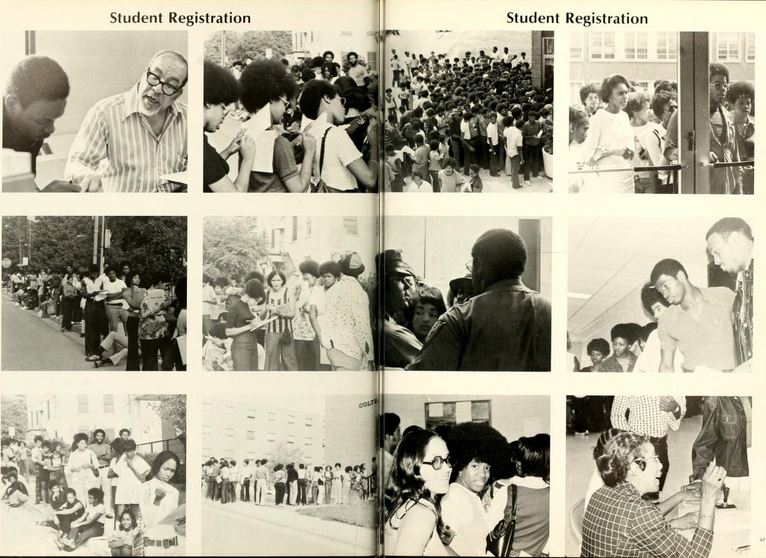
Class registration at Winston Salem State University, 1973. From 1973 The New Ram
As college students across North Carolina head back to class it seems like a good time to take a peek in our NC College Yearbooks collection and see what registering for classes used to look like before we were able to just sit in our dorm room, or coffee shop, or be halfway across the world to sign up on our computers. Until the early 1990s, to sign up for classes involved a lengthy process of waiting in very long lines and hoping that no one in front of you got into the class you wanted or needed before you did. As the images below show, the overwhelming feeling among students about this process was pure frustration. Today’s students can be glad this is one college tradition they do not experience anymore!
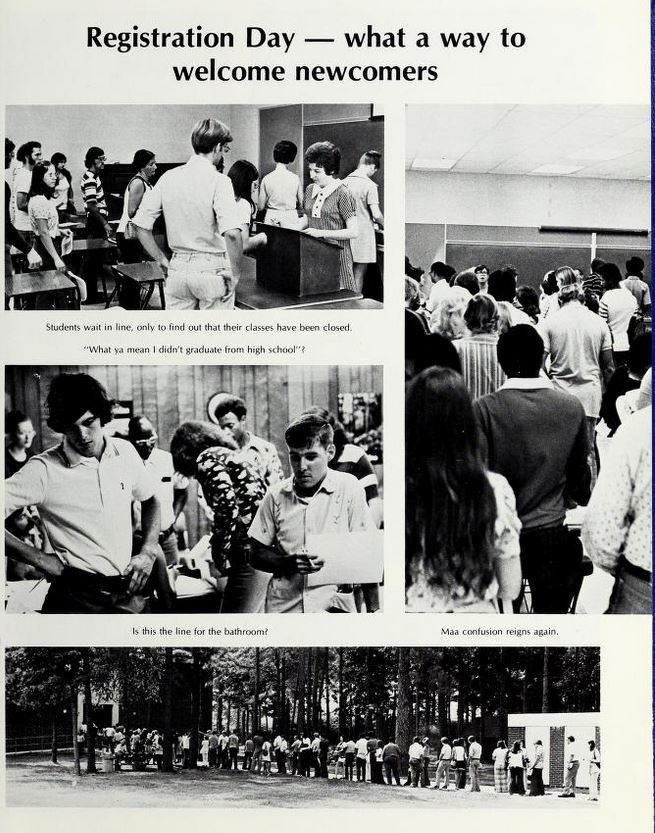
Registration day was a feature in community colleges as well. This is from Wayne Community College’s 1974 yearbook, Insights.
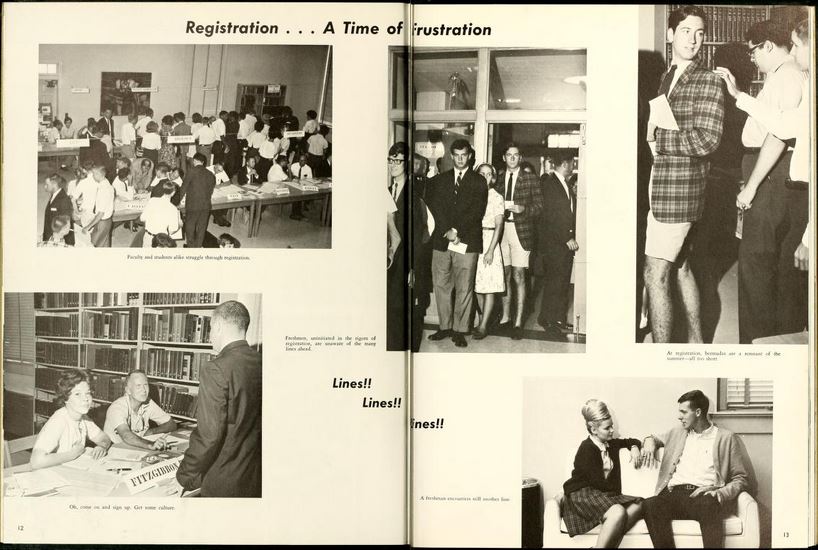
Registration frustration from UNC-Wilmington’s 1966 Fledgling yearbook
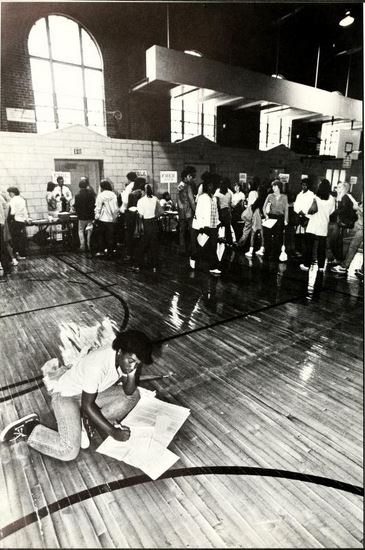
Utilizing the gym floor to figure out classes during registration, from UNC-Chapel Hill’s 1982 Yackety yack
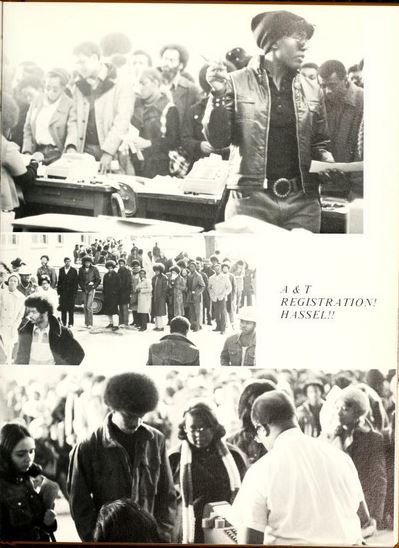
Registration was a “hassel!!” at NC Agricultural and Technical State University in 1974. from 1974 Ayantee
To view more college yearbooks from North Carolina, visit the North Carolina Digital Heritage Center’s NC Yearbooks collection here, and welcome back to school students!
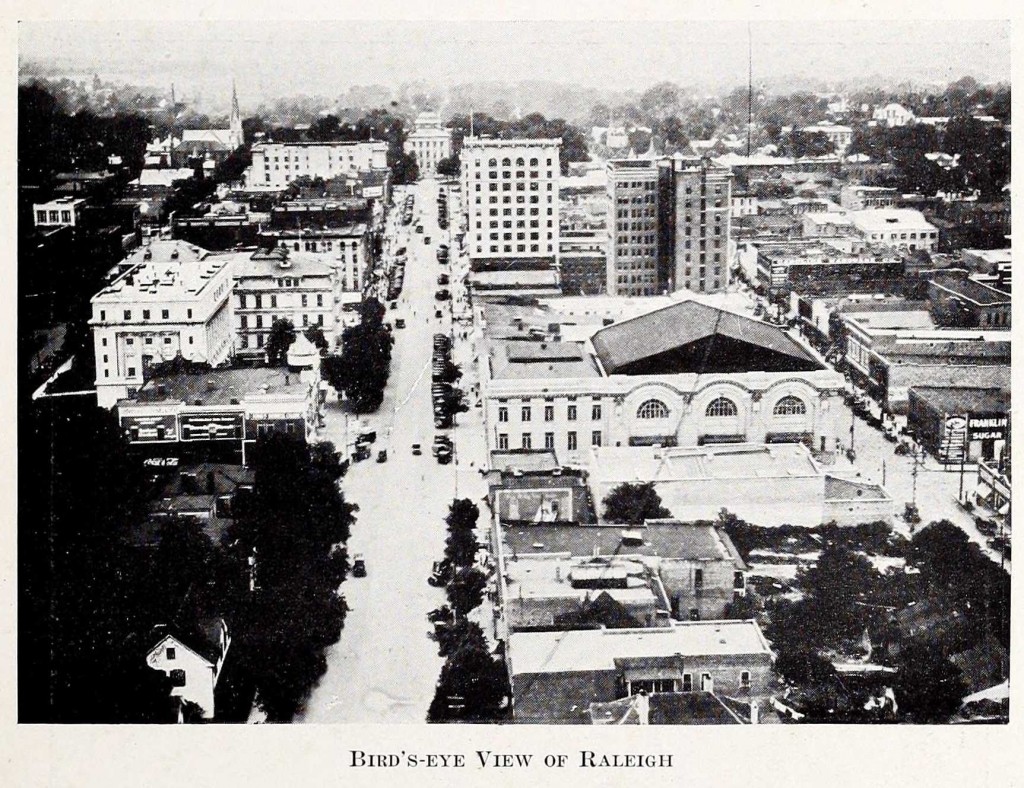
From the 1922 Rattler, Raleigh High School’s yearbook. Part of a photo essay of Raleigh.
The Digital Heritage Center partnered for the first time with the Olivia Raney Local History Library in Raleigh to digitize nearly a hundred Wake County school yearbooks, catalogs, reunion books, and graduation programs. The materials, which span 1909-2008, are windows into the daily lives and times of North Carolinians throughout the century.
Some of these yearbooks come from schools no longer in operation. Here, we’ve provided a brief history of each former school (when available), and a link to the volumes from that school (see section “Closed Schools” below). We also digitized yearbooks from schools that still exist today (see “Current Schools” section at end).
Closed Schools
Charles B. Aycock Junior High School (Raleigh, N.C.)
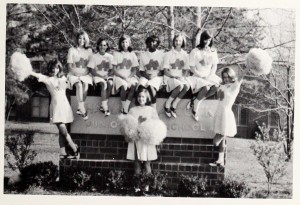
Aycock Junior High School Cheerleaders, 1969.
History: Junior high school in operation from 1965-1979, when its campus was absorbed by William G. Enloe High School, which was built in 1962. The building was and still is known as the “East Building” on Enloe’s campus. Its original students were from the recently closed Hugh Morson Junior High School (formerly Hugh Morson High School).
Volumes: Aycock [1967]; Charles B. Aycock Junior High School [1974]; six of The Owl’s Nest [1968-1973]; two of Owl’s Nest [1975-1976]
Fuquay Springs High School (Fuquay-Varina, N.C.)
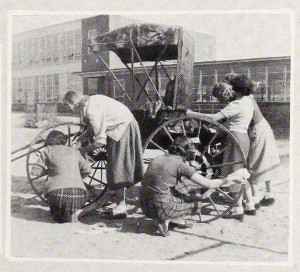
Students of Fuquay Springs High School at work, 1953.
History: Three elementary schools in the area joined together to open Fuquay Springs High School in 1918. The was renamed Fuquay Varina High School in 1963 and operated until fall 1970, when it combined with Fuquay Consolidated High School to form the new Fuquay-Varina High School. That school is still in operation today (history from Fuquay-Varina High School website).
Volumes: three of The Greenbriar [1953-64]
Hugh Morson High School (Raleigh, N.C.)
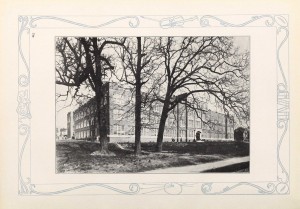
Hugh Morson High School, 1928.
History: On September 2, 1925 the students of the overcrowded Raleigh High School moved into the brand new school called Hugh Morson. The school spanned the block of Morgan Street bounded by Person, Blount, and Hargett Streets. It was named for the long-time teacher and beloved first principal at Raleigh High School, Mr. Hugh Morson. Today, all that remains is a plaque and two gargoyles. The school newspaper was The Purple and Gold; its colors, purple and gold. These colors live on today as the colors of Needham B. Broughton High School (more details in this Good Night Raleigh post; history summarized from an excellent entry in Historical sketches of the Raleigh Public Schools by Mrs J. M. Barbee, 1943).
Hugh Morson High School was demoted to a junior high school in 1955 and operated until 1965, when it closed. Over winter break in 1965, the students were transferred to the new Charles B. Aycock Junior High School and the school was officially closed and demolished in 1966.
Volumes: 18 of The Oak Leaf [1927-1955]; Morson Memories [1962]; Hugh Morson High School Class of 1955 50th Year Reunion Memorial Directory [2005]
Hugh Morson Junior High School (Raleigh, N.C.)
Volumes: PTA Year Book [1963]; Morson Junior High [1964]
Raleigh High School (Raleigh, N.C.)
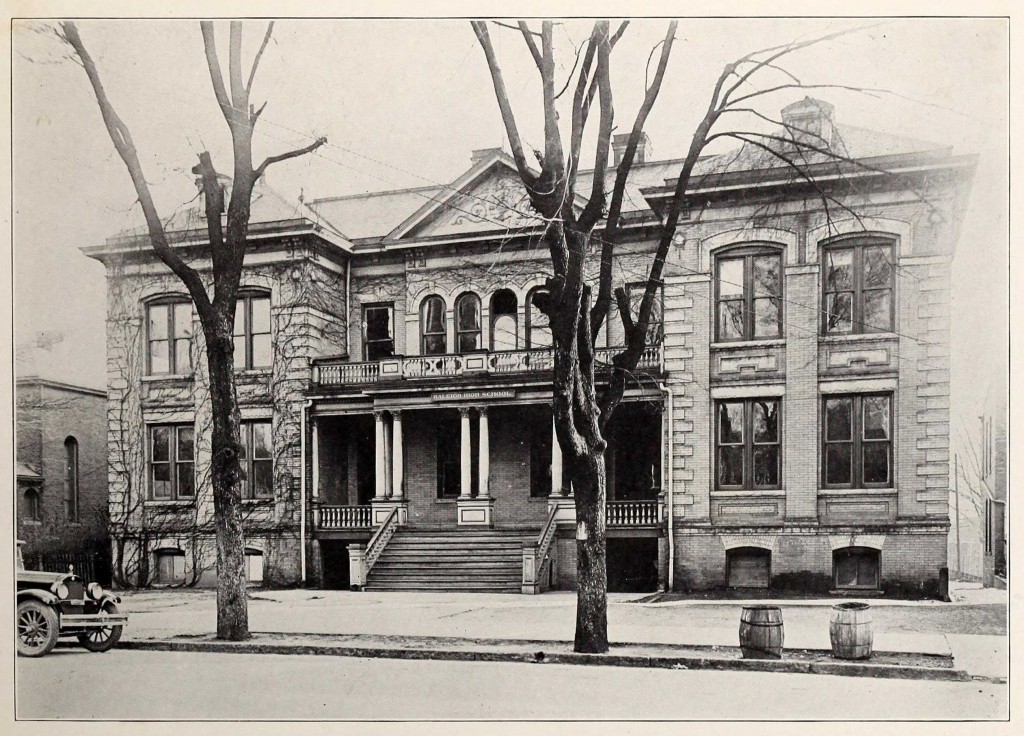
The Raleigh High School building on W. Morgan St, 1923. The school closed in 1929 and was later demolished.
History: Raleigh High School, which preceded both Hugh Morson and Broughton High Schools, was built in 1909 next to “the Raleigh water tower, across the street from fire station #1, on W. Morgan Street” (Good Night Raleigh post). The city of Raleigh decided to build a high school in 1905, reported the News and Observer. The paper also reported that the school’s principal would be Professor Hugh Morson, who ran a successful and well-known boys’ school. The West Morgan Street location was selected for its proximity to both the State and Olivia Raney libraries (the school had no library of its own). The school was built to contain 250-300 students in 1907, but enrollment was soon up to 500. The school built a two-story brick annex during 1921-1922, just east of the city water tower. But schools were soon closed during an influenza pandemic, and the buildings of the high school were used to house patients. In, fact, the school never re-opened. By 1928-1929, the building closed for good, as Hugh Morson and Needham B. Broughton High Schools had both been built. Later the building was used by the Salvation Army, and then divvied up and sold. (Note: history summarized from an excellent entry in Historical sketches of the Raleigh Public Schools by Mrs J. M. Barbee, 1943)
Volumes: seven of The Rattler [1909-1923]; Rattler [1913]; Cylinder [1924]
Rolesville High School (Rolesville, N.C.)
Volumes:Blue Devils [1960]
James E. Shepard High School (Zebulon, N.C.)
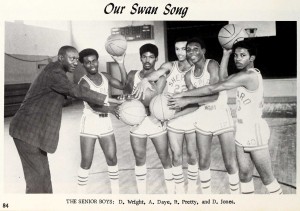
Shepard High School boys’ basketball seniors, 1970.
History: African-American high school from 1933-1970.
Volumes: The Lion [1970]
Wakelon High School (Zebulon, N.C.)
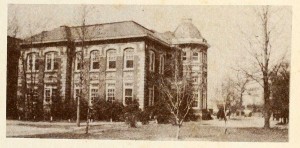
Wakelon High School, side view, 1948.
History: Wakelon School opened in 1908 in an “eclectic brick building” in Italian/Neoclassical style (National Register of Historic Places; the building was added in 1976). It was designed by C. E. Hartage, a Raleigh architect, and features a prominent center octagonal tower. The school’s construction was a big boon for the town of Zebulon, which was incorporated just a year before the school’s construction. Its construction was a result of the 1907 General Assembly act that also established Cary High School. It operated until it was merged with the integrated Zebulon Elementary. The last of the students graduated in the 1980s, and the building was sold to GlaxoSmithKline. It has since been bought back and is now a town hall.
Volumes: two of The Wak-Igh-An [1941-1948]
Washington High School (Raleigh, N.C.)
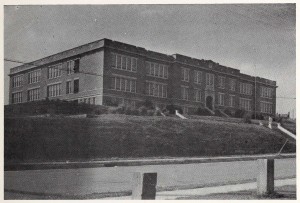
Washington High School building, 1945.
History: In 1869, a school for African-American students was built at West South Street in Raleigh by the American Missionary Society of New York. The school was bought in 1875 by the city of Raleigh and organized as a public elementary school. The school grew, but by 1918 Shaw University and St. Augustine’s College had both discontinued their high school programs, leaving Black students nowhere to pursue education beyond the elementary level. In the fall of 1924, Washington Elementary and High School opened (Historical sketches of the Raleigh Public Schools by Mrs J. M. Barbee, 1943). It was designed by C. A. Gadsen Sayre in the Jacobean style, a popular style for school architecture in in the 1920s, and continued as the only public high school for African Americans in Raleigh from its inception until 1953 (Raleigh Historic Development Commission). The building now holds Washington Gifted and Talented Magnet Elementary School.
Volumes: two of The Echo [1945-1950]
Current Schools
Cary High School (Cary, N.C.)
Volumes: three of Catalogue [1925-1927], a course catalog and campus publication with photographs of the classes and details of the curriculum; yearbooks: The Chsite [1920]; Chsite [1924], six of The Yrac [1952-1962]
St. Mary’s School (Raleigh, N.C.)
Volumes: The Muse [1917]; five of The Stage Coach [1927-1945]
North Carolina State School for the Blind and the Deaf (Raleigh, N.C.)
Now the Governor Morehead School for the Blind.
Volumes: four of The Reflector [1954-1960]
Needham B. Broughton High School (Raleigh, N.C.)
Volumes: 21 of The Latipac [1931-1964]; Needham Broughton High School Classes of 1939-1940 Reunion XXXXV [1984]; Perspectives: 50th Reunion, Class of 1958 [2008]; Journeys: NBBHS Class of 1959 50th Reunion [2009]
To view all of the new Wake County materials, click here. And click here to view all yearbooks from Wake County area high schools.

Printer’s ornaments from the October 1928 and February 1929 issues of the Carolina Magazine.
Issues of the Carolina Magazine from 1927-1948 are now available on DigitalNC. The Carolina Magazine was published for over a hundred years, from 1844-1948, and briefly served as a literary supplement for the Daily Tar Heel (1929-1934). The UNC Student Publications in the North Carolina Collection, Alphabetical Listing has some information on this publication:
Though it changed a great deal in the 104 years of its existence, the magazine always contained long well-written articles and essays on history, art, and education, as well as original stories and poems by Carolina students.
The Student Publications in the North Carolina Collection document (linked above) reveals that some prominent literary figures had early work published in the Magazine–figures such as Walker Percy (1935), and Shelby Foote (1935-36). The Magazine also contained reviews of new books by now classic authors such as Hart Crane, Daniel Defoe, Nathaniel Hawthorne, Ernest Hemingway, Aldous Huxley, Robinson Jeffers, Margaret Mitchell, and the beloved UNC graduate Thomas Wolfe.
Perhaps most interesting, though, is the several issues in the late 1920s that were dedicated to writings of and by Black authors. Influenced by the sweep of the Harlem Renaissance to the north, UNC students invited prominent writer Lewis Alexander to guest edit the May 1927 publication of the Carolina Magazine, which they called the “Negro Number.” In his acknowledgement as guest editor, Lewis Alexander states that it was “the purpose of the editors to present an issue representative of Negro life and art.” The issue contained contributions from Lewis Alexander himself, Countee Cullen, Langston Hughes, and other well-known Black writers. The tradition of dedicating a spring issue to Black authors continued in May 1928. The following year produced the “Negro Play Number” in April 1929, and a final “Negro Number” in May 1930.
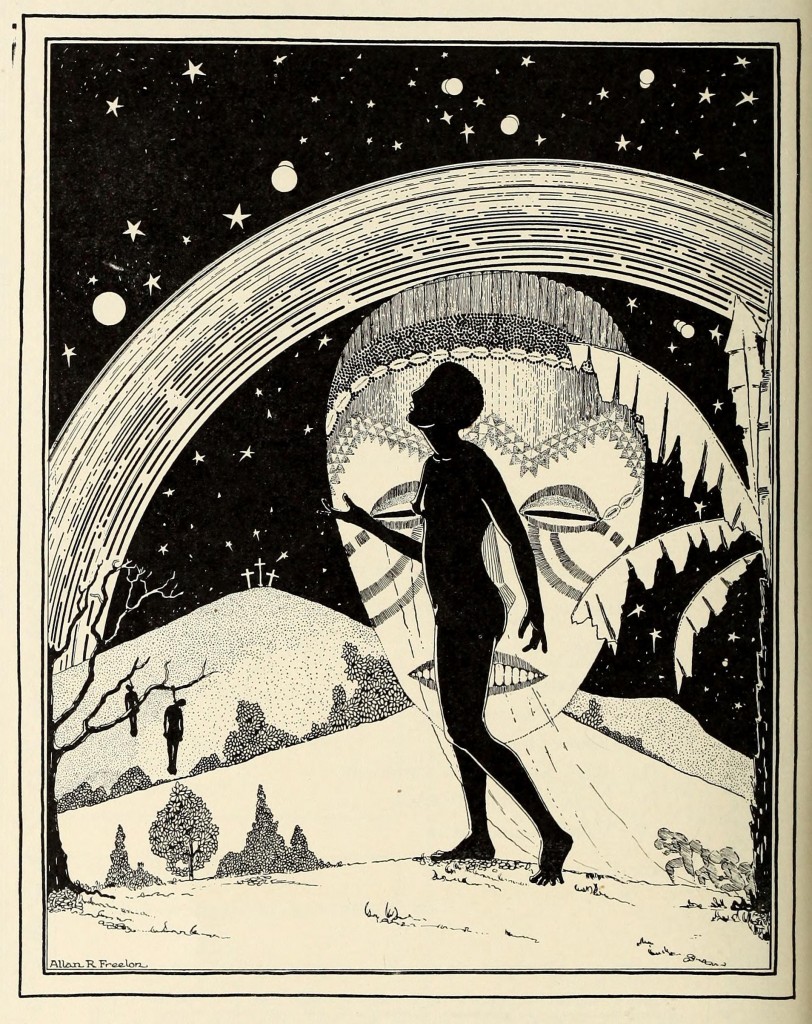
The New Negro, a print by Alan R. Freelon from the May 1928 issue.
For more on the “Negro Number” issues of the Carolina Magazine, read Robert K. Poch’s review of Charles J. Holden’s book, The New Southern University: Academic Freedom and Liberalism at UNC in The American Educational History Journal: Volume 40, #1 and 2, 2013; you can also check out the book itself from University of North Carolina at Chapel Hill libraries.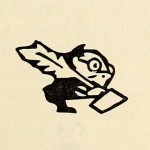

Elon’s The Pendulum staff publishes their ACC picks in 1991.
As you scramble to fill out your brackets, we at the North Carolina Digital Heritage Center thought it would be fun to see how the ACC tournament has been discussed across the state throughout the years since the tournament started in the 1950s. While we all know the big names in the tournament who call North Carolina home, many of the state’s smaller institutions have had a lot to say on the tournament over the years as well, even if their own school or anyone from their town is not participating. A look through the newspapers we have in DigitalNC shows that North Carolina is truly basketball country, especially in March.
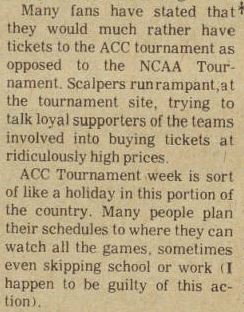
The columnist from the Clarion, Brevard’s student newspaper, in 1979 describing the tournament atmosphere in NC much as one finds it today.
The quote from the article above, from 1979, goes to show that the hyper-attention on the tournament is nothing new. Productivity in North Carolina during this week in March has always been rather low!
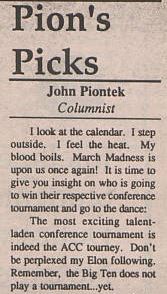
Elon’s student newspaper sports columnist in 1994 brushes off criticism for focusing on the ACC tournament by noting Elon doesn’t participate in any yet.
It seems that all the sports columnists in both town and other institution’s student newspapers had an opinion to offer on who they think will win the tournament that year and overall commentary on the tournament and how it stands up to others for the sport. Many of the columnists remark that having grown up in North Carolina they always followed the tournament, and so brush off any criticism over the fact their own school isn’t participating so why offer commentary?
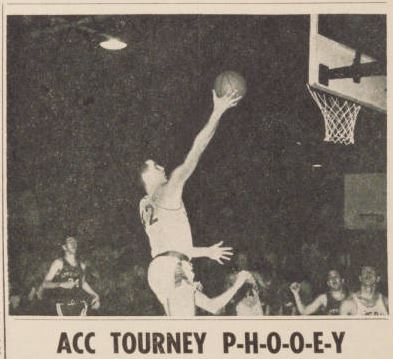
Headline for an article from Louisburg College’s “Columns” student newspaper in 1964, arguing the ACC tournament does not properly reward the best team in the ACC.
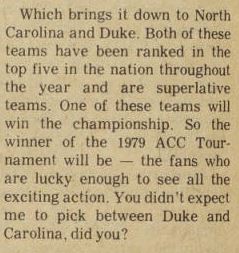
The other student newspapers across the state don’t tend to pick between the big blue rivalry. This is from the Clarion, Brevard College’s student newspaper, in 1979.
Duke and Carolina is the repeated rivalry throughout the sports columns discussing the tournament. There is even a column from Raeford’s The News-Journal that laments that North Carolina State University beat Duke in the first round of the tournament, noting that Duke was clearly the best team in the country.
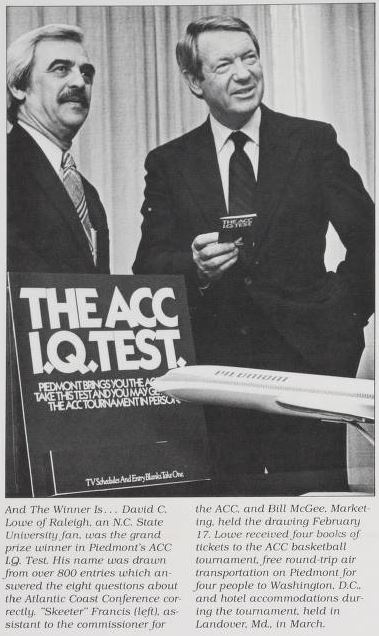
The airlines got in on the ACC fun too. This photograph from Piedmont Airlines’ company paper shows the winner of their ACC trivia contest, with a prize of roundtrip tickets to the tournament in 1981.
To view more ACC tournament news from the past and check out more North Carolina newspapers in general, visit the North Carolina Newspapers page. And as the NC Digital Heritage Center staff’s only bias is for all things North Carolina, we wish the Wolfpack, Deacons, Blue Devils, and Tar Heels well this week!
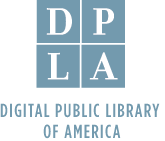 Western Carolina University is the newest North Carolina institution to join the Digital Public Library of America. North Carolina institutions have now contributed over 170,000 digital items.
Western Carolina University is the newest North Carolina institution to join the Digital Public Library of America. North Carolina institutions have now contributed over 170,000 digital items.
In addition to Western Carolina’s collections, the popular North Carolina Maps collection has been added.
The North Carolina Digital Heritage Center is the DPLA’s hub in North Carolina. You can read more about the DPLA and North Carolina in an earlier blog post from the official launch, and our website includes participation information.























